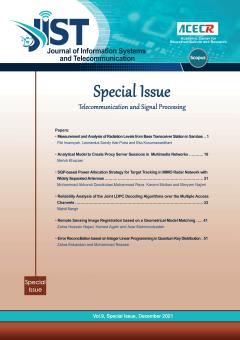-
-
List of Articles
-
Open Access Article
1 - Measurement and Analysis of Radiation Levels from Base Transceiver Station in Sambas
Fitri Imansyah Leonardus Sandy Ade Putra Eka Kusumawardhani -
Open Access Article
2 - Analytical Model to Create Proxy Server Sessions in Multimedia Networks
Mehdi Khazaei -
Open Access Article
3 - SQP-based Power Allocation Strategy for Target Tracking in MIMO Radar Network with Widely Separated Antennas
Mohammad Akhondi Darzikolaei Mohammad Reza Karami-Mollaei Maryam Najimi -
Open Access Article
4 - Reliability Analysis of the Joint LDPC Decoding Algorithms over the Multiple Access Channels
Mahdi Nangir -
Open Access Article
5 - Remote Sensing Image Registration based on a Geometrical Model Matching
Zahra Hossein-Nejad Hamed Agahi Azar Mahmoodzadeh -
Open Access Article
6 - Error Reconciliation based on Integer Linear Programming in Quantum Key Distribution
zahra eskandari mohammad rezaee
-
The rights to this website are owned by the Raimag Press Management System.
Copyright © 2017-2025







